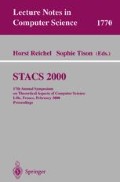Abstract
A visual cryptography scheme for a set \( \mathcal{P} \) of n participants is a method to encode a secret image into n shadow images called shares each of which is given to a distinct participant. Certain qualified subsets of participants can recover the secret image, whereas forbidden subsets of participants have no information on the secret image. The shares given to participants in \( X \subseteq \mathcal{P} \) are xeroxed onto transparencies. If X is qualified then the participants in X can visually recover the secret image by stacking their transparencies without any cryptography knowledge and without performing any cryptographic computation.
This is the first paper which analyzes the amount of randomness needed to visually share a secret image. It provides lower and upper bounds to the randomness of visual cryptography schemes. Our schemes represent a dramatic improvement on the randomness of all previously known schemes.
Access this chapter
Tax calculation will be finalised at checkout
Purchases are for personal use only
Preview
Unable to display preview. Download preview PDF.
References
G. Ateniese, C. Blundo, A. De Santis, and D. R. Stinson, Visual Cryptography for General Access Structures. Information and Computation 129-2, 86–106 (1996).
G. Ateniese, C. Blundo, A. De Santis, and D. R. Stinson, Constructions and Bounds for Visual Cryptography. ICALP 1996, LNCS 1099, 416–428.
M. Atici, S. S. Magliveras, D. R. Stinson, and W.-D. Wei, Some Recursive Constructions for Perfect Hash Families. Journal of Comb. Design, 4, 352–363 (1996).
A. Beimel and B. Chor, Universally ideal secret sharing schemes. IEEE Trans. Inform. Theory, 40(3), 786–794 (1994).
C. Blundo, P. D’Arco, A. De Santis, and D. R. Stinson, Contrast Optimal Threshold Visual Cryptography Schemes. submitted for publication (1998).
C. Blundo and A. De Bonis, New Constructions for Visual Cryptography. Proc. ICTCS’ 98, P. Degano, U. Vaccaro, G. Pirillo, (Eds.), 290–303, World Scientific.
C. Blundo, A. De Santis, and D. R. Stinson, On the Contrast in Visual Cryptography Schemes. To appear on Journal of Cryptology. Available also at Theory of Cryptography Library as ftp://theory.lcs.mit.edu/pub/tcryptol/96-13.ps.
C. Blundo, A. De Santis, and U. Vaccaro, Randomness in Distribution Protocols. Information and Computation, 131, 111–139 (1996).
A. De Bonis and A. De Santis, Visual and Non-Visual Secret Sharing Schemes. submitted for publication.
M. L. Fredman and J. Komlós, On the Size of Separating System and Families of Perfect Hash Functions. SIAM J. Alg. Disc. Math., 5(1), 1984.
T. Hofmeister, M. Krause, and H. U. Simon, Contrast-Optimal k out of n Secret Sharing Schemes in Visual Cryptography. COCOON’ 97, LNCS 1276, 176–185.
R. Impagliazzo and D. Zuckerman, How to Recycle Random Bits. Proc. 21st Annual ACM Symp. on Theory of Computing, 248–255 (1989).
M. Mehlhorn, On the Program Size of Perfect and Universal Hash Functions. Proc. 23rd IEEE Symp. on Foundations of Comp. Science, 170–175 (1982).
M. Naor and A. Shamir, Visual Cryptography. LNCS 950, 1–12 (1995).
D. R. Stinson, An Introduction to Visual Cryptography. Presented at Public Key Solutions’ 97, Toronto, Canada, April 28–30 (1997). Available as http://bibd.unl.edu/stinson/VKS-PKS.ps.
D. R. Stinson and R. Wei, New Constructions for Perfect Hash Families and Related Structures using Combinatorial Designs and Codes. preprint.
G. J. Simmons, W.-A. Jackson, and K. Martin, Decomposition Constructions for Secret Sharing Schemes. Bulletin of the ICA, 1:72–88 (1991).
D. Zuckerman, Simulating BPP Using a General Weak Random Source. Proc. 32nd IEEE Symp. on Foundations of Comp. Science, 79–89 (1991).
Author information
Authors and Affiliations
Editor information
Editors and Affiliations
Rights and permissions
Copyright information
© 2000 Springer-Verlag Berlin Heidelberg
About this paper
Cite this paper
De Bonis, A., De Santis, A. (2000). Randomness in Visual Cryptography. In: Reichel, H., Tison, S. (eds) STACS 2000. STACS 2000. Lecture Notes in Computer Science, vol 1770. Springer, Berlin, Heidelberg. https://doi.org/10.1007/3-540-46541-3_52
Download citation
DOI: https://doi.org/10.1007/3-540-46541-3_52
Published:
Publisher Name: Springer, Berlin, Heidelberg
Print ISBN: 978-3-540-67141-1
Online ISBN: 978-3-540-46541-6
eBook Packages: Springer Book Archive

